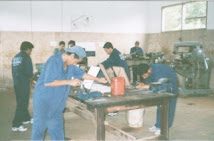
"Semakin Kita fokus pada impian kita. Semakin cepat kita mencapai impian itu.
Fokus menghasilkan energi yang besar, bahkan semakin lama semakin dahsyat. Fokus membuatku bersemangat, berenergi, berkeringat, tetap panas karena membantu aku untuk selalu bergerak. Bergerak melangkah, bergerak lari, bergerak ke arah silau sinar berlian yang memimpinku."
Kita Bisaa!!!
Disusun Ulang Oleh:
Arip Nurahman & Deden Anugrah
Pendidikan Fisika, FPMIPA Universitas Pendidikan Indonesia
&
Follower Open Course Ware at MIT-Harvard University, Cambridge. USA.
Introduction to Applied Nuclear Physics

The Rutherford-Bohr model of the atom. (Courtesy of EPA.)
Level:
Instructors:
Course Description
This course concentrates on the basic concepts of nuclear physics with emphasis on nuclear structure and radiation interactions with matter. Included: elementary quantum theory; nuclear forces; shell structure of the nucleus; alpha, beta, and gamma radioactive decays; interactions of nuclear radiations (charged particles, gammas, and neutrons) with matter; nuclear reactions; and fission and fusion.
The course is divided into three main sections:
- Quantum Mechanics Fundamentals
- Nuclear Structure and Nuclear Decays
- Interactions in Nuclear Matter and Nuclear Reactions
Syllabus
Course Meeting Times
Lectures: 2 sessions / week, 1.5 hour / session
Course Prerequisites
8.02, 18.02, 22.01
Textbooks
Krane, K.S. Introductory Nuclear Physics. Wiley, 1988.
Liboff, R. L. Introductory Quantum Mechanics. Addison-Wesley, 2003.
Problem Sets
The weekly problem sets are an essential part of the course. Working through these problems is essential to understanding the material.
Problem sets will generally be assigned once every week and will be due the same day in the following week. All problem sets will be posted on the course web site.
Problem set solutions will be posted on the web site following the due date. No problem sets will be accepted after the solutions have been posted.
Exams
There will be a two hour mid term and a comprehensive final exam. The final exam will emphasize material from the entire course, and will be a mixture of factual questions and problems.
Term Paper
There is no term paper required for this course.
Grading
The final grade for the course will be based on the following:
| ACTIVITIES | PERCENTAGES |
|---|---|
| Weekly Problem Sets | 30% |
| Mid Term Exam | 30% |
| Final Exam | 40% |
Calendar
| SES # | Topics | Readings & Handouts |
|---|---|---|
| 1 | Intro Lectures: Basic Nucleus Concepts | |
| 2 | Intro Lectures: Wave-Particle Duality & Historical Background | |
| 3 | Quantum Mechanics #1, #2
| Liboff 3.1-3.3 Postulates Handout |
| 4 | Quantum Mechanics #3, #4
| Liboff 4.1, 4.2, 4.3 Liboff 7.5, 7.6, 7.7 |
| 5 | Quantum Mechanics #5, #6
| Liboff 5.1-5.5 |
| 6 | Quantum Mechanics #7, #8
| Liboff 3.4, 3.5, 6.2 Liboff 9.1-9.3 |
| 7 | Quantum Mechanics #9
| |
| 8 | Mid-Term Exam | |
| 9 | Nuclear Structure #1, #2
| Krane 3 Krane 4 |
| 10 | Nuclear Structure #3, #4
| Krane 5 |
| 11 | Nuclear Structure #5 -Radioactive Decay, Alpha Decay | Krane 8 |
| 12 | Gamma Decay | Liboff 10.7 Krane 10 |
| 13 | Nuclear Interactions #1, - Charged Particle Interactions | Krane 9 Krane 7 |
| 14 | Beta Decay Nuclear Interactions #1, - Charged Particle Interactions (Cont'd) | Liboff 10.7 Krane 10 |
| 15 | Nuclear Interactions #2, #3
| Krane 12 |
| 16 | Nuclear Interactions #4, #5
| Krane 13 Krane 14 |
Related Resources
The following is a list of Plasma and Fusion related resources. Some of the web sites have excellent links. You are invited to visit them.
- MIT Plasma Science and Fusion Center
- MIT Plasma Science and Fusion Center - Levitated Dipole Experiment
- The US Department of Energy - Fusion Energy Sciences Program
- The World Wide Web Virtual Library - Plasma Science and Technology-Resources
- The Coalition for Plasma Science
- Princeton Plasma Physics Laboratory
- General Atomics
- University of Wisconsin









